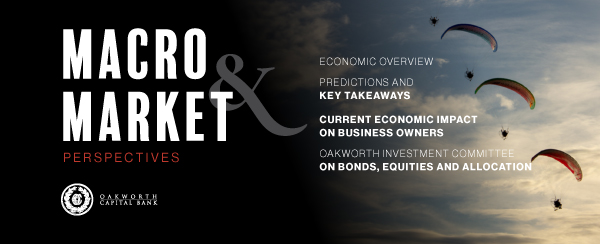Predicting future economic activity involves little more than digesting a massive amount of economic data, playing the odds and coming to a conclusion. Ordinarily, this is a pretty easy to do. As I have told countless people in my career, the U.S. economy is like a massive aircraft carrier in the middle of the Pacific Ocean.
It doesn’t just start and stop on a dime.
As such, if the data is moving in one direction, it is safe to assume it will continue to do so, especially when the data is trending in a consistent and sustainable manner. Simply stated, if the economy is chugging along at 2%, the data hasn’t changed much, you can predict continued economic growth in the 2% range, plus or minus 0.25%.
However, the data has been confounding over the past several years, It has made crystal balls, tea leaves and the old way of doing things nearly obsolete.
How can you predict the future when the present doesn’t make a lot of sense?
As I type here at the end of 2nd quarter of 2023, I could probably make a more coherent argument for an economic downturn than I could continued growth. If you paid me enough, I could even make a pretty solid case for severe economic distress moving forward.
LEADING ECONOMIC INDEX
After all, the Conference Board’s Leading Economic Index (LEI) has been negative for 14 consecutive months through May 2023. Admittedly, the LEI isn’t a household term, but it tracks important data. Things like slope of the yield curve, stock prices, ISM Index of New Orders, building permits for private housing. Leading Credit Index and a number of others.
THE LEI DOESN’T LIE, DOES IT?
Source: Bloomberg Financial
So, when this series is in the red for over a year, folks who do what I do for a living tend to take notice. As you can see in the chart, the only other times when the LEI has been negative for an extended time frame (such as now) were official recessions. These were during the Financial Crisis of 2008-2009 and the relatively mild economic downturn we had at the start of the century (2001).
THE MONEY SUPPLY
Then, there is the question of the money supply. Simply put, it is shrinking (see the chart below).
THE SHRINKING MONEY SUPPLY (M2) IN THE UNITED STATES
Source: Bloomberg Financial
To be sure, the slop doesn’t appear too alarming in the graph. However, shrinkage in the money supply over a trailing 12-month time frame isn’t normal. In fact, it is very abnormal. So much so that it hasn’t happened since 1959. Currently, through the end of May 2023, some $860 billion seems to have vanished from the U.S. economy over the last year.
So, what does this all mean?
LOAN ACTIVITY
Well, it could mean investors have taken money out of their deposit accounts and purchased Treasury bills. Frankly, that wouldn’t be a bad thing.
However, it could also mean banks simply aren’t lending money the way they were. After all, and believe it or not, that is how the financial system creates money, by lending it out.
How? Well, banks take in deposits and make loans. We all know that, right? However, banks still give depositors access to their money. As such, both sides are, or can, use it, essentially doubling it (in a way).
So, what are the banks doing? Are they still lending money?
STAGNANT LOAN GROWTH IN THE UNITED STATES
Source: Bloomberg Financial
This chart tracks all the loans and leases in bank credit on bank balance sheets across the United States.
If you really want to track this at home, the Federal Reserve releases this data every Friday in its H.8 Report.
While the graph above doesn’t look too concerning to the naked eye, again, folks who do what I do for a living take notice. Reason being? It has been essentially flat since the beginning of the year.
Let’s just say banks usually don’t pull in the reins when things are going along smoothly. When they can make a decent spread on credit, they will do so.
It isn’t terribly complicated. Borrow low, lend high, and repeat. If there isn’t any repeat, it means banks aren’t making the same spread OR are worried about the credit worthiness of their counterparties.
Either way, this points to slower economic activity moving forward. The key word there is slower. That doesn’t necessarily mean non-existent. In fact, the path of least resistance is to predict the economy will continue to grow, albeit relatively slowly.
CONSUMER SPENDING
Interestingly, despite higher prices (inflation) over the past 18 months and higher borrowing costs, the U.S. consumer has been defying the odds. By no means has it been going gangbusters’ however, personal consumption expenditures (PCE) have been just enough to keep the economy from slumping worse than it is.
REAL ADVANCE RETAIL SALES
Source: Bloomberg Financial
Did you see anything unusual in this chart other than the sharp spikes during the pandemic and the other pronounced dip in 2008 and 2009? I have been doing this a long time, and I am having a hard time looking at it and coming up with anything better than: “Well, it looks as though the U.S. consumer is hanging in there decently enough. It looks almost normal, really.” If I had to describe this chart as fish or fowl, I would say it was neither.
But, how can this be? Again, inflation the way it has been and higher borrowing costs across the board should be anchors on PCE. Yet they don’t seem to have been, at least not to any sort of Doomsday scenario.
LABOR MARKETS
This doesn’t make a lot of sense until you look at what is happening in the labor markets. If you want unusual, that is a good place to start. Let’s just say, despite all of the headwinds in the U.S economy and sluggish GDP reports, employers still can’t find enough workers.
It seems no matter where you look, there simply aren’t enough hourly workers. If not just hourly, there aren’t enough people who want to stock shelves, root around crawlspaces, fix and/or install HVAC equipment, drive deliver trucks, unclog pipes, operate forklifts, flip burgers and a host of other jobs.
While technology and AI might eventually make yours truly redundant (if they haven’t already) some jobs will need humans for a while longer. If you know where they are hiding, you could make a lot of money as a recruiter.
The underlying reason for the shortage is twofold. First, during the worst of the pandemic, a lot of workers over age 55 retired, dropped out of the workforce, hit the bricks or whatever you want to call it. Ordinarily, this wouldn’t be a bad thing; it wasn’t for a lot of people. After all, as older workers opt out, younger ones take their positions.
It is a virtuous cycle. That is until there aren’t enough people coming into the workforce to take the entry level and hourly work left behind as workers advance up the ladder.
Consider the following:
- In January 2020, right before COVID struck, the Labor Force Participation Rate for 16-to 24-year-olds was 56.7%. As of May 2023, it was 56.3%. Obviously, that is a little lower and would account for a shortage of around 144,000 jobs.
- For workers over 55, the Labor Force Participation Rate was 40.2% in January 2020. As of May 2023, that rate had fallen to 38.4%. A little back of the envelope math suggests this difference represents a decrease of about 1,748,000 jobs.
- When you combine the two, that works out to be a shortfall of 1,892,000 jobs.
But that isn’t all.
According to a number of different resources, there are anywhere from 3-5 million American workers whose primary source of income is “gig economy” work, i.e., part-time positions filled by independent contractors and freelancers. In other words, the Uber, Lyft, Instacart and DoorDash apps or services you constantly use on your phone. For an economy already looking for close to 2 million workers, that presents a problem.
As a result of the two, there is an enormous number of U.S. job openings, and workers can’t fill them fast enough.
CAN THE ECONOMY REALLY COLLAPSE WHEN EMPLOYERS CAN’T FIND ENOUGH WORKERS?
.
Source: Bloomberg Financial
Admittedly, I have discussed this in previous editions of this magazine. But as much as inflation has been an issue recently, the lack of workers has been a prevailing theme. To be sure, the number of openings has dipped a little from its all-time high. However, prior to the pandemic, the most recent observation of 10.1 million would have been the highest monthly number by roughly 2.5 million.
To put that number into perspective, 10.1 million is slightly more than Michigan’s estimated current population.
These openings exist even as the economy has added a little over 4 million net, new payroll jobs over the last 12 months. You read that correctly.
What happens when we create 4 million new jobs? That’s right, we create 4 million new paychecks. And those new paychecks mean we are also creating new consumers. This is important, because PCE constitutes roughly 70% of the GDP equation.
Obviously, how goes the strength of the U.S. consumer is how goes the U.S. economy.
Basically, the sheer strength of the U.S. labor market should be enough to help mitigate any potential downturn. Another way of putting it is continued labor market strength should be able to offset rolling slowdowns in various economic sectors.
In essence, everything shouldn’t hit the fan at the same time as it did in 2008.
And isn’t that worry what keeps folks up at night?
CONCLUSION
In conclusion, and taking it full circle, the U.S. economy doesn’t just start and stop on a dime. There is no reason to think this time will be any different. Labor market strength, which is often a lagging indicator, will be enough to keep the economy from the worst-case scenario. However, all of those headwinds I discussed earlier should keep us from realizing a best-case scenario.
Therefore, the probable-case scenario is continued very modest GDP numbers for the next couple of quarters.
Close to 1,800 words just to get to that.
It is what we do.
For more from our Investment Committee in our 2nd Quarter 2023 Macro & Market Perspectives, click the image below.
The opinions expressed within this report are those of the Investment Committee as of the date published. They are subject to change without notice, and do not necessarily reflect the views of Oakworth Capital Bank, its directors, shareholders or employees.




